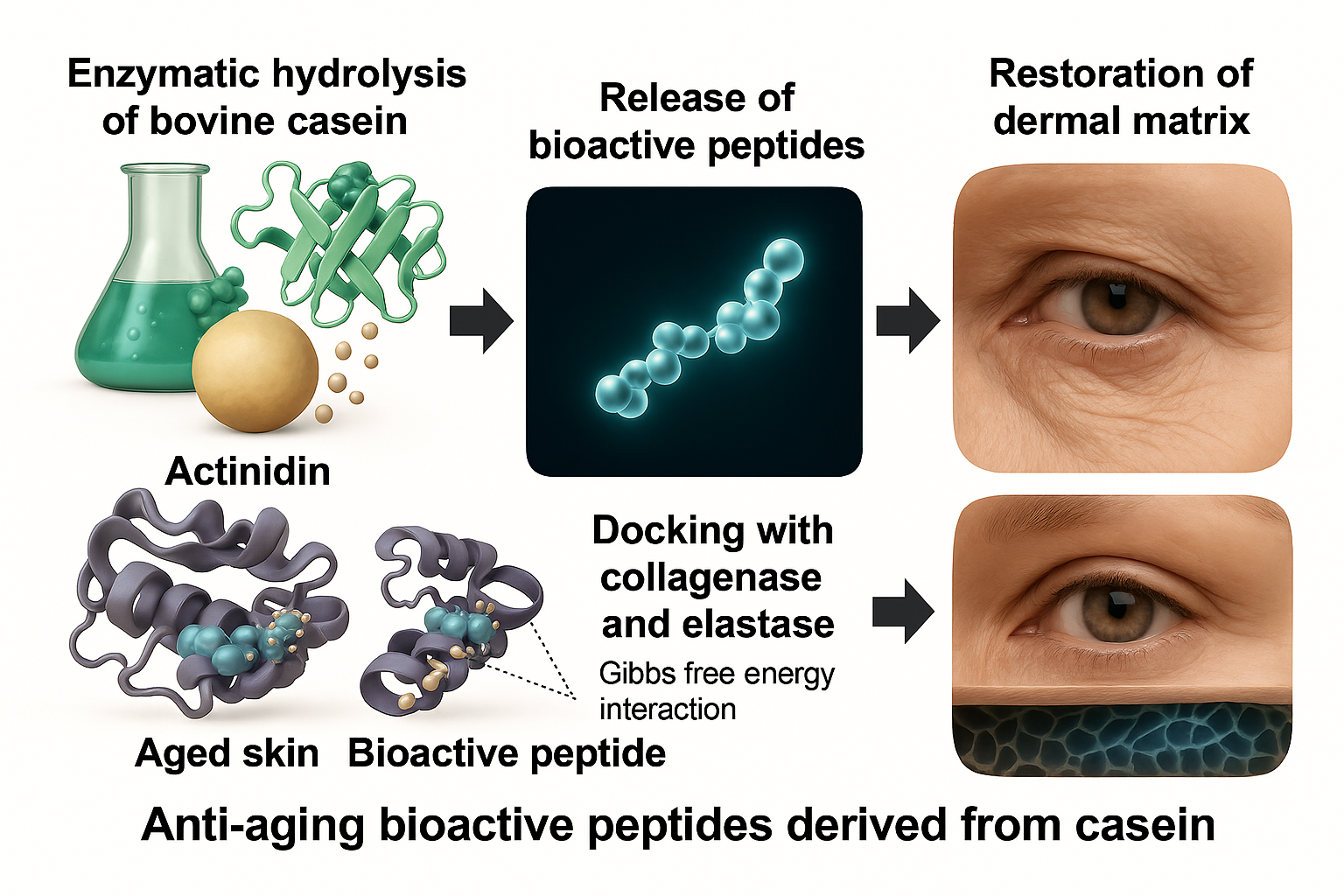Skin aging is a complex biological process primarily driven by oxidative stress and the enzymatic degradation of key structural proteins, collagen and elastin, catalyzed by proteases like collagenase and elastase. These enzymes, classified as matrix metalloproteinases (MMPs), are physiologically regulated, but their activity significantly increases with intrinsic aging and chronic exposure to environmental stressors, particularly ultraviolet (UV) radiation. This leads to the overproduction of reactive oxygen species (ROS), promoting epidermal oxidative stress and accelerating the breakdown of the extracellular matrix, resulting in visible changes such as loss of elasticity, wrinkle formation, and reduced dermal fiber abundance.
In response to this challenge, there has been an intensified search for natural compounds with anti-aging properties that can inhibit collagenase and elastase while neutralizing ROS. Bioactive peptides have emerged as a promising solution for cosmetic formulations due to their inherent antioxidant capacity, low allergenicity, and cost-effective production. These peptides can be sustainably obtained through the enzymatic hydrolysis of accessible protein sources, such as bovine casein, which is known for its diverse physiological properties. Among the enzymes capable of generating these functional peptides, actinidin—a cysteine protease extracted from green kiwi fruit (Actinidia deliciosa)—stands out due to its broad catalytic activity and proven ability to produce peptides with antioxidant and enzyme-modulatory effects. Despite these advantages, its application as a biocatalyst for generating anti-aging peptides from bovine casein has remained largely unexplored.
Methods
Actinidin was extracted, purified, and characterized from green kiwi fruit pulp. This enzyme was then used to hydrolyze commercial bovine casein at 37 °C for 30 minutes, followed by precipitation and centrifugation to isolate the peptide fraction. The in vitro anti-aging potential of these peptides was evaluated by assessing their antioxidant activity (ABTS assay), anti-collagenase, and anti-elastase capacities. Complementing these experimental findings, in silico enzymatic hydrolysis of casein proteins was simulated using Lys-C, and molecular docking analyses were performed to predict peptide sequences with high binding affinity to collagenase and elastase, thereby estimating their potential inhibitory effects.
Key Findings
The study yielded several significant insights into the anti-aging potential of casein-derived peptides:
• Efficient Hydrolysis and Peptide Generation: Actinidin was successfully extracted and purified, confirming a molecular weight close to 27 kDa. It demonstrated high efficiency in hydrolyzing bovine casein, achieving a degree of hydrolysis of 91.6%. In silico simulations further supported this, predicting 100% theoretical hydrolysis that yielded 66 peptide fragments, with 30.3% consisting of 4–8 amino acids, a size range known to be optimal for biological activity and enzyme interaction.
• Moderate In Vitro Anti-Aging Activities:
◦ The resulting hydrolysates exhibited moderate antioxidant activity of 17.5% via the ABTS radical scavenging assay at 0.85 mg/mL.
◦ They showed an anti-collagenase activity of 18.55% at 0.844 mg/mL.
◦ An anti-elastase activity of 28.6% was observed at 0.844 mg/mL. Despite these values being lower than some optimized systems or highly purified compounds, they underscore the multifunctional bioactivity profile of these peptides.
• Identified High-Affinity Peptides through Molecular Docking:
◦ In silico results revealed FALPQYLK as the peptide with the highest affinity for collagenase (∆G = −5.493 kcal/mol). This interaction was stabilized by multiple hydrogen bonds, hydrophobic interactions, and an electrostatic contact, involving residues such as Leu, Tyr, and Lys. Its elongated structure was observed to insert deeply into the enzyme’s zinc-dependent catalytic cleft, suggesting steric hindrance to substrate access.
◦ VIPYVRYL demonstrated the strongest affinity for elastase (∆G = −6.698 kcal/mol). This binding was prominently mediated by Tyr, Val, and Arg residues through three hydrogen bonds and four hydrophobic contacts, positioned near the enzyme’s catalytic triad (Ser195–His57–Asp102), indicating direct inhibition.
• Competitive Inhibition Mechanisms: Structural modeling indicated that the active peptides adopt conformations and engage catalytic residues in a manner comparable to commercial inhibitors, suggesting competitive and substrate-mimicking inhibition mechanisms. Although commercial inhibitors (EGCG for collagenase and FR901277 for elastase) showed generally higher binding energies, the casein peptides presented advantages in residue-level engagement, depth of accommodation, and conformational adaptability.
Looking ahead, the future implications of this research are substantial. It lays crucial groundwork for future studies to focus on purification and further characterization of these peptide extracts, potentially using techniques like LC/MS. The predicted peptide sequences can then be chemically synthesized and rigorously evaluated in in vitro cell lines and in vivo models to provide a more robust validation framework. Ultimately, further research into skin permeation assays and advanced peptide characterization will be essential to guide formulation scalability and clinical relevance, paving the way for the development of sustainable and effective active ingredients for topical anti-aging treatments.
Link to the study: https://www.mdpi.com/2079-9284/12/5/189


